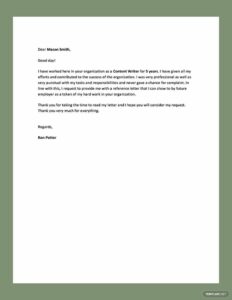Using such a framework increases the likelihood of receiving well-crafted, targeted recommendations. It saves recommenders time and effort by providing clear guidance on what information is most relevant. This, in turn, benefits the requester by presenting a stronger and more cohesive application package.
Further exploration of this topic will cover best practices for creating and utilizing these valuable resources, along with examples and common scenarios where their use is particularly advantageous.
Key Components of a Reference Request
Effective reference requests contain specific elements that facilitate the process and ensure the recommender has the necessary information to write a strong letter of support.
1: Requester Information: Full name, current contact information, and a link to a professional online presence (e.g., LinkedIn profile) enable the recommender to easily identify and connect with the requester.
2: Opportunity Details: A clear description of the position, program, or opportunity for which the recommendation is sought, including the organization’s name and relevant deadlines, provides context for the recommender.
3: Relationship Context: Briefly outlining how the requester knows the recommender and the duration of their relationship helps the recommender frame their assessment.
4: Relevant Skills and Experiences: Highlighting specific skills, accomplishments, or experiences the requester would like the recommender to address ensures the recommendation is targeted and relevant to the opportunity.
5: Resume/CV: Providing a current resume or curriculum vitae offers the recommender a comprehensive overview of the requester’s qualifications and professional background.
6: Reference Template/Form (Optional): Including a template or specific questions for the recommender to consider can streamline the process and ensure consistency in the information provided.
7: Expression of Gratitude: Acknowledging the recommender’s time and effort and expressing sincere appreciation for their willingness to provide a reference is essential.
A well-structured request increases efficiency and maximizes the likelihood of receiving a compelling and effective recommendation. Providing comprehensive information allows recommenders to craft targeted endorsements that strengthen application materials.
How to Create a Personal Reference Request
Creating a well-structured request ensures the process is efficient and maximizes the chances of receiving a strong recommendation. A clear and organized approach benefits both the requester and the recommender.
1: Compile Necessary Information: Gather all relevant details, including the requester’s contact information, a link to a professional online profile (e.g., LinkedIn), and the opportunity’s specifics (organization name, position title, application deadline).
2: Draft an Introductory Paragraph: Explain the purpose of the request, clearly stating the opportunity being pursued and the need for a recommendation. Contextualize the request by briefly describing how the requester knows the recommender and the duration of their relationship.
3: Highlight Relevant Skills and Experiences: Specify particular skills, accomplishments, or experiences the recommender should focus on. This guidance helps ensure the recommendation is targeted and aligns with the opportunity’s requirements.
4: Provide Supporting Documents: Include a current resume or curriculum vitae to provide the recommender with a comprehensive overview of qualifications and professional history. Optionally, a job description or other relevant materials may also be included.
5: Include a Template or Guiding Questions (Optional): Offer a structured template or a set of specific questions for the recommender to address. This can simplify the process and ensure the recommendation addresses key aspects of the requester’s suitability for the opportunity.
6: Express Gratitude and Offer Assistance: Conclude the request by expressing sincere appreciation for the recommender’s time and willingness to provide support. Offer to answer any questions the recommender might have and reaffirm availability for further discussion.
7: Proofread and Send: Before sending the request, thoroughly review for clarity, accuracy, and professionalism. Ensure all necessary information is included and that the tone is respectful and appreciative. Sending the request well in advance of the deadline allows the recommender ample time to craft a thoughtful and effective recommendation.
A comprehensive and thoughtfully prepared request increases the likelihood of receiving a strong, targeted recommendation that significantly strengthens application materials.
A structured approach to requesting recommendations ensures a more efficient and effective process for all parties involved. Providing clear guidelines and relevant information empowers recommenders to craft compelling testimonials that highlight key qualifications and experiences. This, in turn, strengthens application packages and increases the likelihood of favorable outcomes for those seeking opportunities.
Leveraging the advantages of organized frameworks for recommendation requests represents a strategic investment in professional advancement. Thoughtful preparation and clear communication optimize the process, yielding valuable support that can significantly influence selection decisions.


